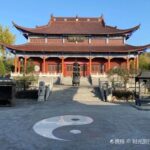The Santasi Temple was founded during the Daye period (605 – 618) of the Sui Dynasty. In the first year of Daguan (1107) during the reign of Emperor Huizong of the Northern Song Dynasty, three towers were built in front of the temple, hence the name ‘Santasi Temple’. During the Hongwu period of the Ming Dynasty, bricks from the three towers were used to build the Maotan Bridge for visiting the tombs of Si and Feng. As a result, the towers were destroyed. It was renovated during the Tianqi period. Under the Dabei Tower in the temple, there is a thousand-year-old boxwood tree and more than a hundred rare peonies. Every year when the peonies are in bloom, literati and refined scholars come to hold a ‘Peony Poetry Gathering’. Wu Guolong, a successful candidate in the imperial examinations of the Ming Dynasty, wrote a poem titled ‘Santasi Temple’: ‘Occasionally passing by Xiaoguan and taking a rest, I feel refreshed and cool until autumn. Birds come down for pine nuts, while I am retained by the fragrance of trees. Looking at the pine trees at leisure, I feel the temple is secluded amid the hustle and bustle. What’s more delightful is that there is fresh water everywhere, just like a small stream.’ In the Qing Dynasty, Fang Dingguo, a Taoist in white, lived here. Xue Shiyu, the magistrate of Hangzhou, had his work ‘The Taoist in White’ circulated, making the Santasi Temple even more famous. The specific opening hours and business status are subject to the opening situation on that day.
Santasi Temple
The Santasi Temple was founded during the Daye period (605 – 618) of the Sui Dynasty. In the f[...]









